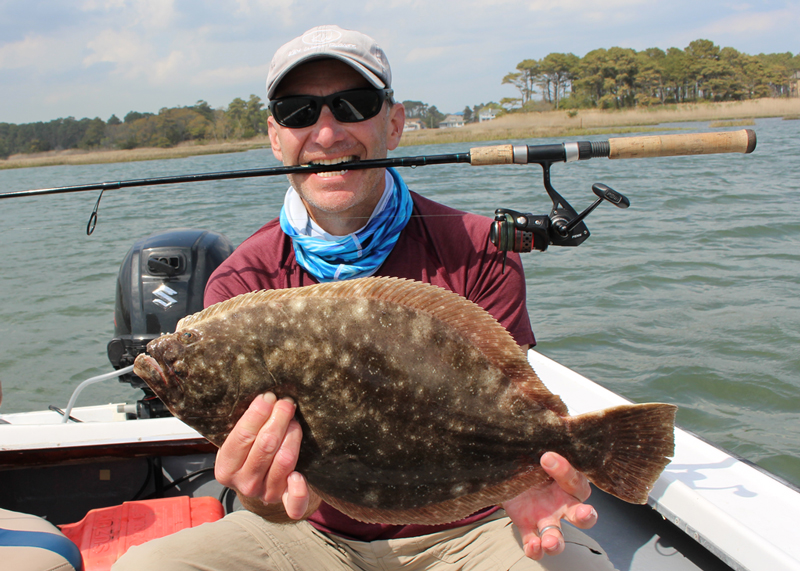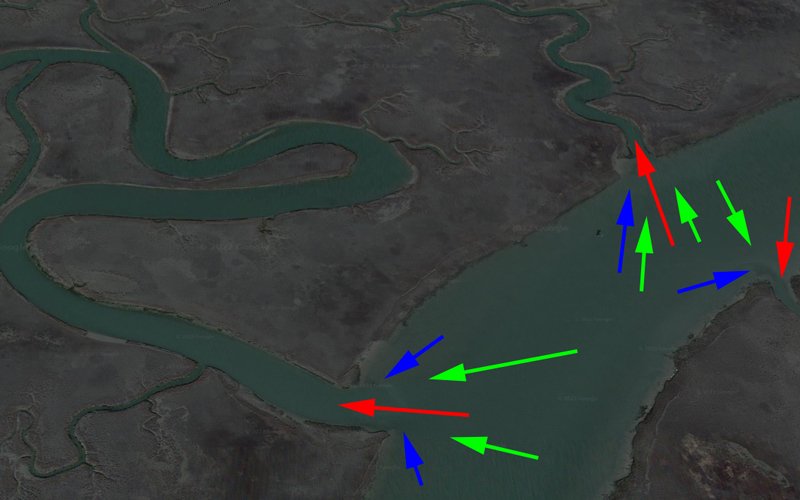For many anglers out there, flounder fishing means drifting around with weighted, baited rigs and relatively heavy gear. And to a light tackle aficionado that’s a darn shame — those flatfish have a unique way of striking and fighting, and going head-to-head with one on ultralight gear is a ton of fun. If that sounds like your idea of a good time then stay tuned, because your chance to hook up with a doormat on light gear is coming up this April.

Spring Fluke
We normally picture flounder sitting on the bottom in relatively deep water along a channel edge or next to structure, in a high-current area, waiting to ambush an incoming baitfish. The traditional method of hooking up in this situation is dragging a Fluke Killer baited with a minnow/squid strip combo (or a Gulp! Swimming Mullet at the wrecks and reefs) along the bottom. And for most of the fishing season, this is a good way to catch these fish. But it often requires a fair amount of weight to hold bottom, and thus, means using relatively heavy tackle. During the spring, however, flatties move into the shallows where they’re vulnerable to light tackle casting and even fly fishing.
Don’t be deceived by the term “shallows.” We’re not talking about five to 10 feet of water — the flounder will push up onto flats and bars that are just a couple feet deep, and sometimes, will be hooked mere inches from marsh grass. What the heck are these fish doing? Traditional theory holds that they move up onto the shallows to enjoy the sun-warmed waters. As the tide begins to fall, they’ll often hunt near the mouths of marsh creeks, which bring both warmer water and a food supply as they drain down. No doubt, there’s truth to this concept. Or, maybe not — who can say what a fish’s motivation is, without question? But one thing is for sure: their presence in these shallow waters allows you to bring light gear to bear.

When the tide is a couple of hours from full high, try working channel edges and flats close to the shorelines and creeks. When it’s almost full high, shift to even shallower areas and shallow water structure such as oyster bars and marsh grass patches separated from the “mainland” marsh. Hop your offering along the bottom at a fairly fast rate, using your rod tip to make the lure jump now and again. If you’re into using fly gear, use short, fast strips and an intermediate sinking line to be sure your offering stays close to the bottom. As the water turns and begins flowing out cast right up into the mouths of the feeder creeks. And after it’s dropped for an hour or two be prepared to focus on deeper water once again.
Geared Up for Early Season Flounder in the Shallows
What lures are best? In this situation, you can go after them by casting three- and four-inch soft plastics and bucktails in the half-ounce range. Some flounder purists stick with a plain white bucktail, some will dress it with a small squid strip, and some will add a Gulp! Shrimp tail. Fly anglers will stick to streamers and deceivers that mimic minnow and shrimp. In low-light conditions or in discolored water, try darker colors like purple, root-beer, or dull orange. Note, however, that flounder always tend to bite better in clear water and sunshine so on days when it’s cloudy, you have to expect a tough bite.
Cast these lures with a six- to seven-foot light action rod with a fast tip, sporting a reel spooled with braid. Unlike bait fishing for flounder you’ll want to set the hook the moment you have a bite, and the braid will help you punch through the flounder’s boney jaws. A few feet of 20-pound fluorocarbon leader caps off the rig.
After the water levels have fallen it’s time to shift your focus to the areas where the flats meet the channel edges and start working slightly deeper. That may mean either upsizing your lead-head, or changing tactics entirely and using the more common baited hook/drift fishing or trolling methods in the deeper channel waters. And on dead low tides when you’ll be looking to find the fish deep, up-sizing the weight will be a must.
Whatever Floats your Boat
In order to access the shoals and shallows, obviously, a small boat is advantageous. Anything that requires more than two feet of draft becomes a handicap, and flat bottom Jon boats, kayaks, and the like will have the best abilities to work in close to marsh cuts and sand bars. But there are a few critical notes about working the shallows in boats. First off, don’t forget that the noise you make will have an effect on the fish’s behavior. Loud bangs, such as those created by a slamming fiberglass hatch, can ruin an area for several minutes. Two-stroke outboards running at idle also create a racket. Running an electric motor is stealthy but will still create prop noise, which is directly related to RPM. Accordingly, approach awesome-looking potential hotspots as slowly as possible. The least-recognized fish-spooking noise? The human voice. Talking at a regular speaking level, much less shouting, is audible from at least 50 feet away under water. Warn your crew to hush the noise levels before coming close to your hotspots, and try to keep the celebratory shouting to a minimum when a fish comes over the gunwales.
So: are you ready to put your light tackle skills to the challenge? You want to hook a true doormat on fly gear? Now’s the time to make it happen.